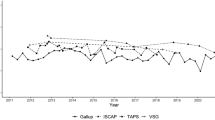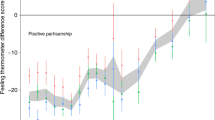Abstract
One of the most intriguing aspects of the debate regarding the persistence of party identification is that proponents of different schools of thought have each managed to use the same quasi-experimental data and similar state of the art techniques to defend their point of view. In this article we argue that this debate cannot be resolved with quasi-experimental data alone and propose another method that we believe can help us triangulate in on the correct answer: experimentation. Two experiments are performed and analyzed. The first tests the hypothesis that party identification is updated in response to the vote choice; the second tests the hypothesis that candidate evaluations influence party choices. The results of our experiments provide some additional support for the traditional conception of partisanship as the unmoved mover of American politics.
Similar content being viewed by others
REFERENCES
Ansolabehere, Stephen, Snyder Jr., James M., and Stewart, III, Charles (2000). Old voters, new voters, and the personal vote: using redistricting to measure the incumbency advantage. American Journal of Political Science 44: 17–34.
Aronson, Elliot, and Carlsmith, J. Merill (1954). Experiments in social psychology. In Gardner Lindzey and Elliot Aronson (eds.), The Handbook of Social Psychology, 2nd edition, vol. 2. Reading, MA: Addison-Wesley Publishing Company.
Barone, Michael, and Ujifusa, Grant. (1999). The Almanac of American Politics. Washington, DC: National Journal.
Bartels, Larry M. (1991). Instrumental and ‘quasi-instrumental’ variables. American Journal of Political Science 40: 777–800.
Bem, Daryl J. (1967). Self-perception: an alternative interpretation of cognitive dissonance phenomena. Psychological Review 74: 183–200.
Bem, Daryl J. (1972). Self-perception theory. In Leonard Berkowitz (ed.), Advances in Experimental Social Psychology, vol. 6. New York: Academic Press.
Berelson, Bernard R., Lazarsfeld, Paul, and McPhee, William N. (1954). Voting: A Studyof Opinion Formation in a Presidential Campaign. Chicago & London: The University of Chicago Press.
Brody, Richard A. (1977). Stability and change in party identification: Presidential to off-years. Paper presented at the Annual Meeting of the American Political Science Association.
Brody, Richard A., and Rothenberg, Lawrence S. (1988). The instability of partisanship: an analysis of the 1980 presidential election. British Journal of Political Science 18: 445–465.
Burnham, Walter Dean. (1965). The changing shape of the American political universe. American Political Science Review 59: 7–28.
Burnham, Walter Dean (1970). Critical Elections and the Mainsprings of American Politics. New York: Norton.
Campbell, Angus, Converse, Philip E., Miller, Warren, and Stokes. Donald (1960). The American Voter. New York: John Wiley.
Campbell, Angus, Gurin, Gerald, and Miller, Warren E. (1954). The Voter Decides. Evanston, IL: Row, Peterson and Company.
Campbell, Donald T. (1969). Ethnocentrism of disciplines and the fish-scale model of omniscience. In Muzafer Sherif and Carolyn W. Sherif (eds.), Interdisciplinary Relationships in the Social Sciences. Chicago: Aldine Publishing Company.
Campbell, Donald T., and Stanley, Julian C. (1963). Experimental and Quasi-Experimental Designs for Research. Chicago: Rand McNally College Publishing Company.
Campbell, James E., Munroe, Mary, Alford, John R., and Campbell, Bruce A. (1986). Partisanship and voting. In Samuel Long (ed.), Research in Micropolitics, vol. 1. Greenwich, CT: JAI Press.
Converse, Philip E. (1969). Of time and partisan stability. Comparative Political Studies2: 139–171.
Converse, Philip E. (1972). Change in the American electorate. In Angus Campbell and Philip E. Converse (eds.), The Human Meaning of Social Change. New York: Russell Sage Foundation.
Converse, Philip E. (1975). Public opinion and voting behavior. In Fred I Greenstein and Nelson W. Polsby (eds.), The Handbook of Political Science, vol. 4. Reading, MA: Addison-Wesley.
Converse, Philip E., and Markus, Gregory B. (1979). Plus ca change...: the new CPS election study panel. American Political Science Review 73: 32–49.
Cover, Albert (1977). One good term deserves another: the advantage of incumbency in congressional elections. American Journal of Political Science 21: 523–541.
Delli Carpini, Michael X., and Keeter, Scott (1989). What Americans Know about Politics and WhyIt Matters. New Haven & London: Yale University Press.
Erikson, Robert S., MacKuen, Michael B., and Stimson, James A. (1998). What moves macropartisanship? A response to Green, Palmquist, and Schickler. American Political Science Review 92: 901–912.
Fearon, James (1991). Counterfactuals and hypothesis testing in political science. World Politics, 43: 169–195.
Fiorina, Morris P. (1977). Congress: Keystone of the Washington Establishment. New Haven: Yale University Press.
Fiorina, Morris P. (1981). Retrospective Voting in American National Elections. New Haven: Yale University Press.
Fisher, Ronald, Grant, Peter, Hall, Ronald, and Keasly, Loraleigh (1990). The development and testing of strategic simulation of intergroup conflict. Journal of Personality124: 223–240.
Fiske, Susan, and Taylor, Shelley (1991). Social Cognition. New York: McGraw-Hill.
Franklin, Charles H. (1992). Measurement and dynamics of party identification. Political Behavior 14: 297–309.
Franklin, Charles H., and Jackson, John E. (1983). The dynamics of party identification. American Political Science Review 77: 957–973.
Frymer, Paul (1999). UneasyAlliances: Race and Party Competition in America. Princeton: Princeton University Press.
Gelman, Andrew, and King, Gary (1993). Why are presidential election campaign polls so variable when votes are so predictable? British Journal of Political Science 23: 409–451.
Green, Donald Philip (1990). The effects of measurement error on two-stage, least squares estimates. In James A. Stimson (ed.), Political Analysis, vol. 2. Ann Arbor: University of Michigan Press.
Green, Donald Philip, and Palmquist, Bradley (1990). Of artifacts and partisan instability. American Journal of Political Science 34: 872–902.
Green, Donald Philip, and Palmquist, Bradley (1994). How stable is party identification? Political Behavior 16: 437–466.
Green, Donald Philip, and Schickler, Eric (1993). Multiple-measure assessments of party identification. Public Opinion Quarterly 57: 503–535.
Iyengar, Shanto, and Kinder, Donald R. (1987). News that Matters: Television and American Opinion. Chicago & London: University of Chicago Press.
Jackson, John E. (1975a). Issues and party alignment. In Louis Maisel and Paul M. Sacks (eds.), The Future of Political Parties. Beverly Hills, CA: Sage Publications, Inc.
Jackson, John E. (1975b). Issues, party choices, and presidential votes. American Journal of Political Science 19: 161–185.
Jeannerod, Marc (1998). Representations for action. In Michael Sobourin and Fergus Craik (eds.), Advances in Psychological Science, Vol. 2: Biological and Cognitive, vol. 2. Hove, Psychology Press/Erlbaum United Kingdom: Taylor & Francis.
Jennings, M. Kent, and Markus, Gregory B. (1984). Partisan orientations over the long haul: results from the three-wave political socialization panel study. American Political Science Review 78: 1000–1018.
Jones, Edward E., Davis, Keith E., and Gergen, Kenneth J. (1961). Role playing variations and their informational value for person perception. Journal of Abnormal and Social Psychology 63: 302–310.
Jones Edward E., and Nisbett, Richard E. (1972). The actor and the observer: divergent perceptions of the causes of behavior. In Edward E. Jones, David E. Kanouse, Harold H. Kelley, Richard E. Nisbett, Stuart Valins, and Bernard Weiner (eds.), Attribution: Perceiving the Causes of Behavior. Morristown, NJ: General Learning Press.
Kern, Jeffrey (1991). An evaluation of a novel role play methodology: a standardized ideographic approach. Behavior Therapy 22: 13–29.
Kipper, David, and Uspiz, Varda (1987). Emotional and cognitive responses in role playing. Journal of Group Psychotherapy 39: 131–142.
Knight, Kathleen (1985). Ideology in the 1980 election: ideological sophistication does matter. Journal of Politics 47: 828–853.
Knight, Kathleen (1990). Ideology and public opinion. Micropolitics 3: 59–82.
Larson, Richard J., and Marx, Morris L. (1986). An Introduction to Mathematical Statistics and Its Applications. 2nd edition. Englewood Cliffs, NJ: Prentice-Hall.
Lewin, Kurt, Lippitt, Ronald, and White, Ralph K. (1939). Patterns of aggressive behavior in experimentally created 'social climates.’ Journal of Social Psychology 10: 271–299.
MacKuen, Michael B., Erikson, Robert S., and Stimson, James A. (1989). Macropartisanship. American Political Science Review 42: 661–689.
MacKuen, Michael B., Erikson, Robert S., Stimson, James A., Abramson, Paul R., and Ostrom Jr., Charles W. (1992). Question wording and macropartisanship. American Political Science Review 86: 475–486.
Markus, Gregory B. (1982). Political attitudes during an election year: a report on the 1980 NES panel study. American Political Science Review 76: 538–560.
Markus, Gregory B., and Converse, Philip E. (1979). A dynamic simultaneous equation model of electoral choice. American Political Science Review 73: 1055–1070.
Meier, Kenneth J. (1975). Party identification and vote choice: the causal relationship. Western Political Quarterly 28: 496–505.
Miller, Warren E., and Shanks, J. Merrill (1982). Policy directions and presidential leadership: alternative interpretations of the 1980 presidential election. British Journal of Political Science 12: 299–356.
Miller, Warren E., and Shanks, J. Merrill (1996). The New American Voter. Cambridge, MA: Harvard University Press.
Nisbett, Richard E., and Wilson, Timothy D. (1977). Telling more than we can know: verbal reports on mental processes. Psychological Review 84: 231–259.
Page, Benjamin I., and Jones, Calvin C. (1979). Reciprocal effects of policy preferences, party loyalties, and the vote. American Political Science Review 73: 1071–1089.
Petrocik, John R. (1981). PartyCoalitions: Realignments and the Decline of the New Deal PartySy stem. Chicago: University of Chicago Press.
Riker, William H. (1986). The Art of Political Manipulation. New Haven: Yale University Press.
Schacter, Stanley, and Singer, Jerome (1962). Cognitive, social and physiological determinants of emotional states. Psychological Review 69: 379–399.
Schattschneider, E.E. (1975). The Semisovereign People: A Realist's View of Democracy in America. Hinsdale, IL: The Dryden Press.
Schickler, Eric, and Green, Donald Philip (1995). Issue preferences and the dynamics of party identification: a methodological critique. In John R. Freeman (ed.), Political Analysis, vol. 5. Ann Arbor: University of Michigan Press.
Sears, David O., and Valentino, Nicholas A. (1997). Politics matters: political events as catalysts for preadult socialization. American Political Science Review 91: 45–65.
Serra, George, and Moon, David (1994). Casework, issue positions, and voting in congressional elections: a district analysis. Journal of Politics 56: 200–213.
St. Lawrence, Janet, Kirksy, William, and Moor, Tamara (1983). External validity of role play: assessments of assertive behavior. Journal of Behavioral Assessment 5: 25–34.
Stokes, Donald E. (1963). Spatial models of party competition. American Political Science Review 57: 368–377.
Sundquist, James L. (1983). Dynamics of the Party System. Revised edn. Washington, DC: The Brookings Institution.
Targrud, Laurie, and Holburn, Stephen (1992). Developing external validity: role play for assessment of social skills: a behavior analytic approach. Behavioral Assessment14: 3–4.
Valins, Stuart (1966). Cognitive effects of false heart-rate feedback. Journal of Social and PersonalityPsy chology 4: 400–408.
Wattenberg, Martin P. (1994). The Decline of American Political Parties, 1952–1992. Cambridge, MA: Harvard University Press.
Wolfe, Joseph, and Roberts, Richard (1993). A further study of the external validity of business games: Five year peer group indicators. Simulations and Gaming 24: 21–32.
Zaller, John R. (1992). The Nature and Origins of Mass Public Opinion. New York: Cambridge University Press.
Author information
Authors and Affiliations
Rights and permissions
About this article
Cite this article
Cowden, J.A., McDermott, R.M. Short-Term Forces and Partisanship. Political Behavior 22, 197–222 (2000). https://doi.org/10.1023/A:1026610113325
Issue Date:
DOI: https://doi.org/10.1023/A:1026610113325




